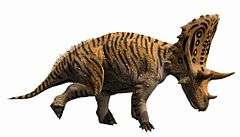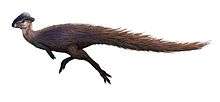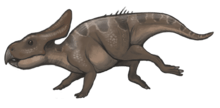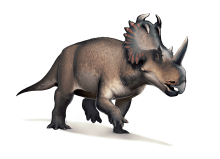Judiceratops
| Judiceratops | |
|---|---|
 | |
| Restoration | |
| Scientific classification | |
| Kingdom: | Animalia |
| Phylum: | Chordata |
| Clade: | Dinosauria |
| Order: | †Ornithischia |
| Family: | †Ceratopsidae |
| Subfamily: | †Chasmosaurinae |
| Genus: | †Judiceratops Longrich, 2013 |
| Species: | †J. tigris |
| Binomial name | |
| Judiceratops tigris Longrich, 2013 | |
Judiceratops (/ˌdʒuːdiːˈsɛrətɒps/ JOO-dee-SERR-ə-tops) is an extinct genus of chasmosaurine ceratopsid dinosaur that lived approximately 78 million years ago during the latter part of the Cretaceous Period in what is now Montana, United States. Judiceratops was a ground-dwelling, quadrupedal herbivore. It represents the oldest known chasmosaurine dinosaur.[1]
Description
The holotype YPM VPPU 022404 consists of an incomplete skull which includes postorbital horns, parts of the frontals, prefrontals, and lacrimals, parts of the right squamosal and parietals, the occipital condyle and parts of the supraoccipital. Several other specimens are known which have similar squamosal bones, but all are very incomplete. Judiceratops shows a distinctive combination of characters, not seen in any previously described ceratopsid. Its frill (parietal bone) has a broad midline bar, a rounded caudal margin, and highly reduced osteoderms (bony projections) on the rear edge of the frill, the epiparietals. The osteoderms which project from the side of the frill and formed by the squamosal (episquamosals), are enlarged forward but decrease in size towards the back. The postorbital (located above the eyes) horns are moderately elongate, inclined forward and outwards, and have an unusual teardrop-shaped cross section.[1]
Classification
Judiceratops is a basal chasmosaurine. It is more primitive than most genera within the subfamily with the exception of Mercuriceratops. The below cladogram follows Longrich (2015), who named a new species of Pentaceratops, and included nearly all species of chasmosaurine.[2]
| Chasmosaurinae |
| |||||||||||||||||||||||||||||||||||||||||||||||||||||||||||||||||||||||||||||||||||||||||||||||||||||||||||||||||||||||||||||||||
Paleoecology
Provenance and occurrence
The remains of the holotype specimen of Judiceratops YPM VPPU 022404 were recovered from the Judith River Formation in Hill County, Montana. The specimen was collected in brown/green mudstone and gray/yellow sandstone which dates to the Campanian stage of Late Cretaceous period, approximately 78 million years ago. This specimen is housed at the Yale Peabody Museum.
Fauna and habitat

Judiceratops shared its paleoenvironment with bony fishes, amphibians, the Choristoderan Champsosaurus, the hadrosaur Brachylophosaurus canadensis, the pachycephalosaur Colepiocephale lambei, the theropods Dromaeosaurus, Gorgosaurus and Troodon, and with fellow ceratopsians Albertaceratops, Medusaceratops and Avaceratops.
See also
References
- 1 2 Longrich, N. R. (2013). "Judiceratops tigris, a New Horned Dinosaur from the Middle Campanian Judith River Formation of Montana". Bulletin of the Peabody Museum of Natural History. 54: 51–65. doi:10.3374/014.054.0103.
- ↑ Longrich, N. R. (2014). "The horned dinosaurs Pentaceratops and Kosmoceratops from the upper Campanian of Alberta and implications for dinosaur biogeography". Cretaceous Research. 51: 292. doi:10.1016/j.cretres.2014.06.011.


